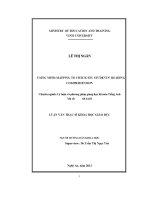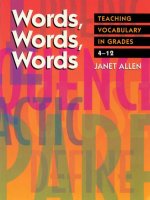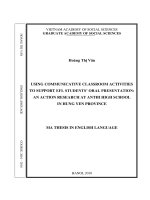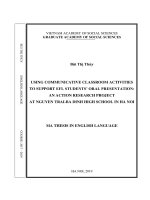TEACHING VOCABULARY ITEMS THROUGH CONTEXT TO ELEMENTARY EFL STUDENTS
Bạn đang xem bản rút gọn của tài liệu. Xem và tải ngay bản đầy đủ của tài liệu tại đây (168.29 KB, 16 trang )
SEMANTICS – FINAL ASSIGNMENT
VIETNAM NATIONAL UNIVERSITY OF HANOI
UNIVERSITY OF LANGUAGE AND INTERNATIONAL STUDIES
POST GRADUATE DEPARTMENT
SEMANTICS
(FINAL ASSIGNMENT )
Title : TEACHING VOCABULARY ITEMS THROUGH CONTEXT
TO ELEMENTARY EFL STUDENTS
Name:
Nguyen Thi Nhu Quynh
Course:
K18 C
Instructor: M.A Ha Cam Tam
Deadline:
28/07/2010
Nguyễn Thị Như Quỳnh – K18C
1
SEMANTICS – FINAL ASSIGNMENT
HA NOI – YEAR 2010
Nguyễn Thị Như Quỳnh – K18C
2
SEMANTICS – FINAL ASSIGNMENT
TEACHING VOCABULARY ITEMS THROUGH CONTEXT TO
ELEMENTARY EFL STUDENTS
INTRODUCTION
1. Problem statement and background to the study
Vocabulary as a major component of language learning has been the object of
numerous studies each of which has its own contribution to the field. Laufer
(1997) states that vocabulary learning is at the heart of language learning and
language use. In fact, it is what makes the essence of a language. Without
vocabulary speakers cannot convey meaning and communicate with each other in a
particular language.
Although vocabulary has been the subject of many studies, few researches have
revealed the effective techniques of vocabulary teaching. So it is of prime importance
to attempt to find the
most
effective
technique
of
vocabulary
teaching.
According to Allen (1983), all experienced language teachers confirm the important
role of words and know that the lack of them leads to feeling of insecurity; on the other
hand, the teachers’ attitude toward teaching vocabulary and the classroom techniques
varies enormously. Different techniques are used by teachers, such as teaching the
words: through lists, translation, synonyms, antonyms, contexts, realia, and so on.
Some teachers believe before teaching vocabulary to their students, they should have
been taught the grammar of the foreign language. Therefore, they give little or no
attention to vocabulary. Allen (1983) also states that in many English language
classes, even where teachers have devoted much time to vocabulary teaching, the
results have been disappointing. Sometimes, after months or even years of English,
many of the words most needed have never been learned. Especially in countries where
English is not the main language of communication, many teachers want more help
with vocabulary instruction than they used to receive.
Vocabulary is an inseparable part of any language learning process. It would be
impossible to learn a language without vocabulary. The important role of
vocabulary has been emphasized in all different methods in language teaching.
Nguyễn Thị Như Quỳnh – K18C
3
SEMANTICS – FINAL ASSIGNMENT
According to Rivers (1981), “vocabulary cannot be taught. It can be presented,
explained, included in all kinds of activities, but it must be learned by the
individual” (p. 110). She continues, “As language teachers, we must arouse interest
in words and a certain excitement in personal development in this area” (p. 110). She
suggests that language teachers must help their students by giving them ideas on how
to learn vocabulary and some guidance on what to learn.
Poor vocabulary knowledge of elementary EFL students is a matter of serious
concern among those in and around education, and their quest for finding suitable
remedies is getting more and more intense. If this study manages to show an
effective technique in vocabulary teaching, we may get some steps closer to
finding of a remedy for poor vocabulary knowledge of our elementary EFL
learners. Therefore, this study presents a contextualization method in order to find
one of the most effective techniques of vocabulary teaching. The new words are
taught in the context using contextual clues and the students infer the meaning of
words from the context. It should be noted that the method together with the
traditional
way
of
teaching
vocabulary
through
definitions, synonyms, and
translations are mostly used by teachers to teach vocabulary items to elementary EFL
students. So it is of prime importance to find the most effective technique
ofvocabulary teaching.
DEVELOPMENT
I. Theoretical background
1.1 Definition of context
There are various definitions about context. I present general agreement of it by
summing up the essentials stated by several experts as follow:
1. Background, environment, framework, setting, or situation surrounding an event or
occurrence.
2. Words and sentences that occur before or after a word or sentence and imbue it with a
particular meaning.
Nguyễn Thị Như Quỳnh – K18C
4
SEMANTICS – FINAL ASSIGNMENT
3. Circumstances under which a document was created, including its function, purpose,
use, time, the creator, and the recipient.
1.2 Definition of vocabulary
Longman Dictionary of Contemporary English (1995) presents six meanings of word
“vocabulary” as follow:
-
All the words that someone knows, learns or uses
-
The words that are typically used when talking about a particular subject.
-
All the words in a particular language.
-
The word failure/ compromise, etc. is not in somebody’s vocabulary used to say
that someone never thinks of accepting failures, etc.
-
A list of words with explanation of their meaning in a book for learning foreign
languages.
-
A list of the codes or terms used in a computer system.
1.3 Importance of vocabulary and vocabulary learning in EFL context
In the context of learning EL as a foreign language, the vital role of vocabulary is
inevitable. This has been claimed by many linguists and experts in the field. Wilkins
(cited in Thornbury, 2002: 13) learly stated that “without grammar, very little can be
conveyed; without vocabulary, nothing can be conveyed”. To be
short and concise,
when comparing the important of grammar and vocabulary, both mentioned statement
above show that most of learner’s improvement was created when learner
himself/herself learned more words and expressions. It was also emphasized when it
came to communicate that “you can say very little with grammar, but you can almost say
anything with word” (Thornbury, p 13).
You can understand vocabulary words based on the context of the passage - the words,
clauses and phrases around the unknown vocabulary word. You don’t have to memorize
all the vocabulary words in the dictionary! For example, you might not understand the
word, acerbity, by itself, but this sentence, “The acerbity of the lemon caused the little
girl to spit out the bite she had just taken. ” makes you understand that the general
meaning of acerbity must be “bitter or sour”. The context clues "lemon" and "spitting
Nguyễn Thị Như Quỳnh – K18C
5
SEMANTICS – FINAL ASSIGNMENT
out the bite", which provide more information in the sentence, help you understand what
the vocabulary word means.
Context clues are words and phrases in a sentence which help you reason out the meaning of an
unfamiliar word. Oftentimes you can figure out the meanings of new or unfamiliar vocabulary
by paying attention to the surrounding language. The table below gives the types of clues,
signals and examples of each clue.
Type of
Context Clue
Definition
Signals
Examples
but, in contrast,
howeve
Antonym or
Phrases or words that
Contrast Clue indicate opposite
r,
Unlike his quiet and low key
instead family, Brad is garrulous.
of,
unlike,
yet
is defined as,
means,
the
term,
Definition or
Phrases or words that
Example Clue define or explain
[a term Sedentary individuals,
in
people who are not very
boldfac active, often have diminished
e or
health.
italics]
set off
with
comma
s
Nguyễn Thị Như Quỳnh – K18C
6
SEMANTICS – FINAL ASSIGNMENT
The information
The meaning is
derived from the
General
Knowledge
experience and
background
knowledge of the
reader; "common
sense" and logic.
may be
someth
ing
basical
ly
familia
Lourdes is always sucking up
to the boss, even in front of
others. That sycophant just
doesn't care what others
think of her behavior.
r to
you
in other word,
that is,
Another word or
also
Restatement or phrase with the same
known
Synonym Clue or a similar meaning is
as,
used.
someti
The dromedary, commonly
called a camel, stores fat in
its hump.
mes
called,
or
In addition to context clues are word parts: prefixes, roots and suffixes.
1.4 Stage of teaching vocabulary through context
1.4.1 Presenting
Actually, the very least learners need to learn both the meaning and the form of a new
word. Therefore, one of the easiest way to help learners to understand new word is
context. Teachers give examples including interesting and easy situation so that
learners can refer the meaning of new words through that context.
For example, with beginners, teachers can present some new words through context by
making sentences such as following:
1- All the family are in the living room. The father is reading newspaper and the
Nguyễn Thị Như Quỳnh – K18C
7
SEMANTICS – FINAL ASSIGNMENT
children are watching TV.
2- Jame’s mother is in the kitchen now. She is cooking lunch.
3- The boys are playing with a ball in the garden. They are playing under the apple
trees.
4- A: Where is your car? It is not in your house.
B: I have parked it in the garage.
…
1.4.2 Practicing
In this case, the use of planned activities for recycling and reactivate the new
vocabulary is of necessity.
1.4.3 Consolidating and Revising
In accordance with presenting and putting words into practice, checking students’
comprehension and revising those words are a final important stage I teaching this
specific field. For this stage, learners can give more contexts that new words are used
to understand better.
III. Implications for teaching Elementary EFL students
Since vocabulary is a very important part of the language, a teacher must equip himself
with up-to-date techniques and methods of teaching them. So, the results of this
research can be valuable for language teachers. Teachers should think of ways to
provide less successful learners with vocabulary learning strategies. This should be done
by making them aware of the need to become independent learners by recognizing the
strategies they possess and those they lack. Learner’s attention should be directed toward
the strategies successful learners benefit from EFL teachers should make learners
practice a wide range of vocabulary learning strategies ranging from decontextualized
and medical strategies to contextualized one. This enable learners to deal with any
unknown vocabulary they many encounter both in and out of class context.
The strategy for teachers
Several of these columns this year have explored ideas for nurturing student vocabulary
growth. Researchers like Beck, McKeown, and Kucan (2002) maintain that explicit
vocabulary instruction is a significant but often missing component in developing
reading comprehension in our classrooms. Vocabulary study that is embedded in
Nguyễn Thị Như Quỳnh – K18C
8
SEMANTICS – FINAL ASSIGNMENT
discussions of written texts is particularly valuable.
Step 1: Select a core of tier 2 words for student examination from material students are
reading in class. Teachers may typically identify “difficult” words from a text, ask
students to ascertain the meanings of these words, and then quiz them in some fashion,
perhaps asking for definitions and demonstration of usage in a sentence.
Beck, McKeown, and Kucan caution against this practice, arguing that many students
merely copy a simplistic definition from the dictionary, fixating perhaps on a familiar
synonym, without really gaining a solid understanding for the new word. As a result,
nearly two-thirds of the sentences penned by students are out of sync, as students misuse
the new word or create awkward, odd, or nonsensical usages.
Instead, when identifying tier 2 words from, say, a chapter or short story, focus on
vocabulary that can be connected to key themes or ideas in the text. These tier 2 words
represent the most meaningful vocabulary to highlight for instruction, because they will
naturally coincide with discussions and other activities in which students will be
engaged. As a result, these words become part of the discourse of learning while
students explore a written text.
It can certainly be suggested that all of the words in the opening paragraph could merit
further study. But which of these words are especially germane to the study of this work
of literature? Although we are talking about only a small sample of vocabulary from this
chapter (from only a single paragraph), we can already notice some words that might be
especially relevant to an understanding of “The Great Gatsby.”
Step 2: Rather than sending students to the dictionary, start with a knowledge-rating
activity. Ask students to evaluate their current level of knowledge about each target
word:
K - I know it; H - I have a hunch what it means; S - I’ve seen it but I don't know it; and
N - I've never seen it before today.
Nguyễn Thị Như Quỳnh – K18C
9
SEMANTICS – FINAL ASSIGNMENT
Next produce from the story the actual contexts for each of the target words, and display
with an overhead projector. For example, students will meet our Gatsby words in the
following contexts: “I was privy to the secret griefs of wild, unknown men” ... and ...
“Most of the confidences were unsought – frequently I have feigned sleep . . .”
Step 3: Now that students have taken stock of their own level of knowledge of the target
words and have been provided with further information about each word with an
example of usage, ask students to begin to “explain” each word in terms of what they
know or think they might know. Emphasize that you are not seeking a “tidy” definition,
but instead are seeking to articulate useful associations and various facets of a word’s
meaning.
For example, some students may note that Revelations is a book of the Bible. Or that
sometimes an athlete feigns injury to get out of practice. Or that an outdoor toilet, such
as in state parks, is referred to as a privy by some people.
During these vocabulary explanations, offer at least one additional example for each
word that expands understanding beyond the original context.
Step 4: Embed these target words in classroom activities and purposefully interject them
into ongoing discussions of the texts so that students are hearing them as well as reading
them. Provide students with multiple opportunities to “test-drive” these tier 2 words as
they talk about and write about the book, story, or selection. In particular, include them
in assessments. For example, students could be asked: “Explain how the following
words can be related to an understanding of Gatsby’s character.”
In addition, ask students to self-select other tier 2 words that can be useful in talking
about each of the characters in a novel or ideas in a passage. These words should be
logged into their personal “word banks,” which are comprised of new words they spot in
their reading. Remind students to include the contexts (phrases or sentences) of these
new words as they record them in a section of their class notebooks
Also, it could help those dealing with foreign language teaching, such as syllabus
Nguyễn Thị Như Quỳnh – K18C
10
SEMANTICS – FINAL ASSIGNMENT
designers, material developers, test makers, and the like.
For example, teachers can design some following tasks to teach new words in context:
Task 1: vocabulary in context
1. "Every second, 1 hectare of the world's rainforest is destroyed. That's equivalent to
two football fields."
What does "equivalent to" mean?
a) more than
b) less than
c) the same as
2. "In British Columbia, where, since 1990, thirteen rainforest valleys have been
clearcut, 142 species of salmon have already become extinct."
What does "clearcut" mean?
a) a few trees have been cut down
b) many trees have been cut down
c) all the trees have been cut down
3. "Logging, however, provides jobs, profits, taxes for the government and cheap
products of all kinds for consumers, so the government is reluctant to restrict or control
it."
What does "reluctant" mean?
a) doesn't want to
b) is not allowed to c) would like to
Task 2: use the context to find approximate meaning of these words or expressions.
1. team-mates ____________________
5. youth
2. rose
____________________
6. murdered _____________________
3. poorly
____________________
7. NBA
_____________________
8. fans
_____________________
4. amaze
____________________
_____________________
Task 3: using context to find the meaning of italic worlds
Nguyễn Thị Như Quỳnh – K18C
11
SEMANTICS – FINAL ASSIGNMENT
1- Scotland is a cold country. In winter, there is often a heavy fall of snow.
2- Damavand is a very high mountain near Tehran. Next Friday, I’m going to climb it.
3- There is a big lake near our city. You can swim and go fishing there.
4- There are three ways here. I don’t know where to go. Take out your map, and show
me the right way.
5- The children tied a piece of rope to the tree and used it as a swing.
6- Horse is a nice animal. It carries many things and you can also ride on it.
CONCLUSION
Vocabulary is central to language and is of great significance to language
learners. Words are the building blocks of a language since they label objects, actions,
ideas without which people cannot convey the intended meaning. The prominent role
of vocabulary knowledge in second language learning has been recognized by
theorists and researchers in the field. Accordingly, numerous types of approaches,
techniques, exercises and practices have been introduced into the field to teach
vocabulary. It has been suggested that teaching vocabulary should not only consist of
Nguyễn Thị Như Quỳnh – K18C
12
SEMANTICS – FINAL ASSIGNMENT
teaching specific words but also aim at equipping learners with strategies necessary to
expand their vocabulary knowledge.
As we listen and read, we often meet new words in contexts. O’Harra (1984) claimed
that context is the setting or surroundings of a word; therefore, when we listen to
someone’s talk, the context of a word is the statement that includes the word.
Sometimes we read words in a written context. Thus, the paragraph may tell us what
the new word means, or enough clues may be provided in the sentence which
contains the word; or even one or two nearby words may explain the meaning of a
new word we find in the text when reading.
Nguyễn Thị Như Quỳnh – K18C
13
SEMANTICS – FINAL ASSIGNMENT
REFERENCES
Allen, V. (1983). Techniques in teaching vocabulary. New York: Oxford University Press.
Bowen, J. J. & H. Madson, A. Hilferty (1985). TESOL techniques and procedures.
London:Newbury House.
Brown, H. D. (2006). Principles of language learning and teaching. NJ: Englewood
Cliffs, Prentice Hall.
Carter, R. & M. McCarthy (1988). Vocabulary and language teaching. London:
Longman.
Farhady, H., Jafarpoor, A. & Birjandi, P. (1996). Language skills testing: From
theory to practice. Tehran: SAMT.
Hatch, E. & Brown, C. (1995). Vocabulary, semantics, and language education.
Cambridge: Cambridge University Press.
Raimes, A. (1983). Techniques in teaching writing. Oxford: Oxford University
Press. Rivers, W. M. (1981). Foreign language skills. Chicago: University of
Chicago Press.
Weatherford, H.J. (1990). Techniques for learning vocabulary. New York: Oxford
University Press.
Nguyễn Thị Như Quỳnh – K18C
14
SEMANTICS – FINAL ASSIGNMENT
Nguyễn Thị Như Quỳnh – K18C
15
Final Assignment –General Linguistics
Nguyen Thi Nhu Quynh – K18C
16









